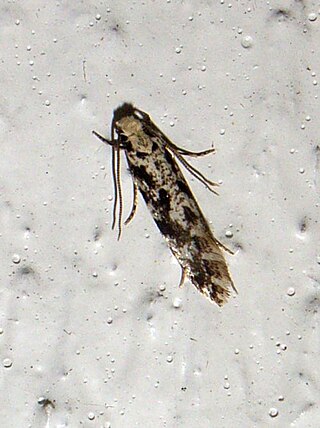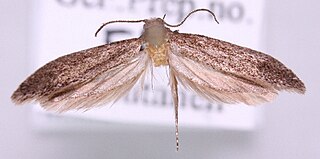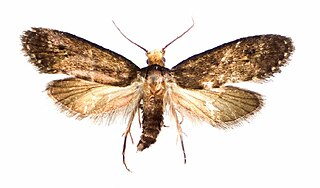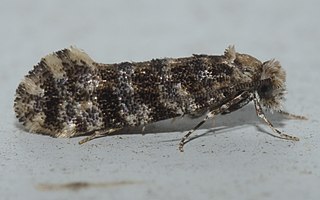
Tineidae is a family of moths in the order Lepidoptera described by Pierre André Latreille in 1810. Collectively, they are known as fungus moths or tineid moths. The family contains considerably more than 3,000 species in more than 300 genera. Most of the tineid moths are small or medium-sized, with wings held roofwise over the body when at rest. They are particularly common in the Palaearctic, but many occur elsewhere, and some are found very widely as introduced species.

Monopis obviella is a species of tineoid moth. It belongs to the fungus moth family (Tineidae), and therein to the nominate subfamily Tineinae. It is the type species of Blabophanes, today treated as a junior synonym of the genus Monopis. M. crocicapitella was only separated from the present species in 1859, and is still frequently confused with it even by rather recent sources.

Acrolepiopsis is a genus of moths in the family Acrolepiidae.
Cimitra is a genus of moths belonging to the family of Tineidae. Most species of this genus are found in Africa but Cimitra sechusella Walker, 1864 is found in Southeast Asia.
Hapsiferona is a genus of moths belonging to the family Tineidae.

Ateliotum is a small genus of the fungus moth family, Tineidae. It belongs to the subfamily Myrmecozelinae.
Archinemapogon is a somewhat disputed genus of the fungus moth family, Tineidae. Within this group, it belongs to the subfamily Nemapogoninae. It is apparently an extremely close relative of the type genus of its subfamily, Nemapogon, and some authors include it there.

Nemapogon is a genus of the fungus moth family, Tineidae. Therein, it belongs to the subfamily Nemapogoninae. As evident by its name, it is the type genus of its subfamily.

Nemaxera is a genus of the fungus moth family, Tineidae. Therein, it belongs to the subfamily Nemapogoninae. The genus is considered monotypic, with the single species Nemaxera betulinella placed here.

Elatobia is a genus of moths belonging to the family Tineidae.

Monopis is a genus of the fungus moth family, Tineidae. Therein, it belongs to the nominate subfamily, Tineinae.

Niditinea is a genus of the fungus moth family, Tineidae. Therein, it belongs to the nominate subfamily, Tineinae.
Reisserita is a genus of moths belonging to the family Tineidae.

Pelecystola is a genus of moths belonging to the family Tineidae.

Xylesthia is a genus of moths belonging to the family Tineidae.

Tinea is a genus of the fungus moth family, Tineidae. Therein, it belongs to the subfamily Tineinae. As evident by its name, it is the type genus of its subfamily and family. Established as one of the first subgroups of "Phalaena", it used to contain many species of Tineidae that are nowadays placed in other genera, as well as a few moths nowadays placed elsewhere.
Setomorpha is a monotypic moth genus in the family Tineidae described by Philipp Christoph Zeller in 1852. Its only species, Setomorpha rutella, the tropical tobacco moth, was described by the same author in the same year. It is a widely spread species that has been distributed by commerce over much of the warmer parts of Africa, Eurasia, Malaysia, Australia, many Pacific islands and North and South America.

The Phycitinae are a subfamily of snout moths. Even though the Pyralidae subfamilies are all quite diverse, Phycitinae stand out even by standards of their family: with over 600 genera considered valid and more than 4000 species placed here at present, they unite up more than three-quarters of living snout moth diversity. Together with the closely related Epipaschiinae, they are apparently the most advanced lineage of snout moths.

Ceratophaga vastella, or the horn moth, belongs to the clothes moth family Tineidae and is noted for its larva's ability to feed on keratin from the horns and hooves of dead ungulates, and occasionally on dried fruit or mushrooms. Keratin, a protein which makes up skin, hair, nails and feathers, is extremely resistant to proteolysis by the enzymes from specialised micro-organisms such as fungi and bacteria.
Phaulernis is a genus of moths in the family Epermeniidae.














